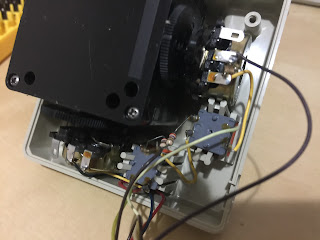Some time ago, a friend gave me this 8MB RAM card for the Apple IIGS. There was nothing wrong with it, except that three to four of the little plastic clips that hold down the SIMMs to the sockets were broken. This rendered the card unusable.
In order to fix the sockets properly, you are going to need a few things:
- A good desoldering tool. I highly recommend the Hakko FR300.
http://amzn.to/2jnOcsj - Replacement 2x30 SIMM sockets. I ordered four from here:
https://www.king-cart.com/cgi-bin/cart.cgi?store=phoenixent&product_name=HWS9229
It may also help to have some solder paste, and keep your soldering gun and solder handy.
Before we begin, take out all the SIMMs:
You can see that two of the plastic clips are broken (see lower left of picture):
Here's a closer view:
This shows the broken clip on the top slot, and the almost broken-off clip on the bottom slot.
The replacements! These ones come with a metal clip, so they should last a bit longer than the original ones. I think they are the same SIMM sockets used on the Briel Computers RAM card.
And so we begin. I put some solder paste on the 60 pins on the first socket to help with the flow, and did a first pass with my brand new desoldering tool. I used a 650oF setting. Not bad, but not completely clean:
I did a second pass with the desoldering tool, and tried to pop the socket out with a small screwdriver. The socket came out with a little pop... probably not a good sign!
Test fit to make sure the replacement SIMM socket is a match. All the 60 metal pins align, and the two plastic nubs at the bottom align with the holes on the card as well.
The second socket went a little easier as I was getting the hang of using the tool.
And within a few minutes, I was able to remove the third socket.
The fourth one took a while, because the desoldering tool lost its vacuum power. I thought at first that I just needed to replace the filter, but it turns out that the nozzle got jammed.
You can tell that the nozzle is jammed if you can't insert the cleaning pin all the way through the nozzle (and up to the solder receiving chamber). I had to break out my drill and a 0.7 mm drill bit, and simultaneously heat the nozzle, activate the vacuum, and drill the hole through the nozzle to clear the jam. And with my fourth hand...
Subsequently I was able to remove the fourth socket.
I almost got it out perfect, but not quite. It turns out one of the pins had not been totally desoldered, so when I popped the socket off... one of the vias popped off too, carrying a fair bit of the trace with it. It comes as no surprise that this pin / trace was one of the ground pins. I carefully pushed it back into the hole and I flattened the trace as much as I could, and tested continuity between the top and bottom of the board.
You can see evidence of this at the top left row:
Some minor scratches on the bottom. A careful continuity test on the traces involved showed that all connections were still good.
The easy part was slotting in the replacement SIMM sockets, and soldering them in place:
After seating the SIMMs in, a quick boot confirms the RAM is found:
And the ultimate test is to run some memory tests overnight.
Success!
- Be patient with the desoldering process. Do not pry the sockets off!
- Make sure to have a strong vacuum going on your desoldering tool. Stop work if necessary to replace the filters and clear any jams to ensure that you have a 100% working tool.
- As described in the user's manual, heat only the pin, not the base of the connections. Once the solder melts (easy to see as the solder paste will melt too)... quickly push the nozzle down over the hole to create a stronger vacuum for the tool and activate the tool vacuum. You know you have done this right, when the hole is left completely clean of solder.
- If not all the solder is cleared / hole is not yet 100% clean, resolder the hole with some new solder, and try to desolder again.
- When done properly, there is no need to pop the sockets out. They fall out on their own.
Lastly, don't assume that, just because the SIMMs came with the card, that all the SIMMs are 1MB. :) It turns out I had received a mixed bag of SIMMs containing both 1MB and 256kB SIMMs. This is a version of what you'll get when you try to boot with mixed memory:
tl;dr The Hakko FR300 is an essential tool for any rework.















































